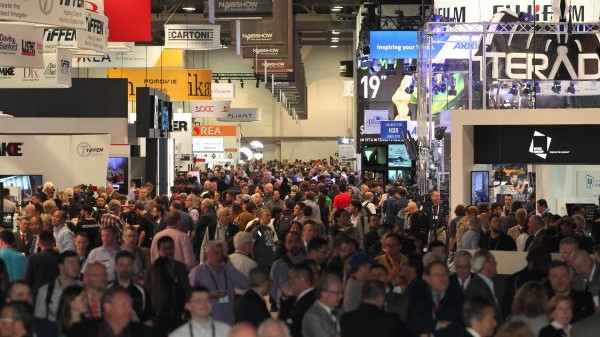Survey: Trade Shows Still Vital to Broadcast Tech Market
Report shows pandemic accelerated evolving relationships between vendors and customers

As the media and entertainment tech industry reels from the cancellation of another important trade show, a new report from the Bubble Agency concludes that in-person industry events are still a main source of business networking and transactions.
The report, Marketing Media Technology: Revealing what broadcast and media technology buyers want from their suppliers, was researched by Caretta Research in partnership with U.K.-based Bubble Agency—a PR company which counts a number of video technology vendors as its clients—and is based on the analysis of detailed focus group interviews and survey data gathered from a broad range of industry leaders in Q3 2021.
The report concluded that despite the cancellation of industry trade shows, in-person events remain the most popular channel for buyers to keep up with industry trends and vendor news, chosen by 83% of respondents. But it also noted that as the options of connecting buyers and vendors have increased through social media and email marketing campaigns, the role of trade shows evolved, even prior to the pandemic.
“Trade shows increasingly play a more important role in closing sales than in generating pipeline, with content-based marketing raising awareness long before the convention begins,” the report noted.
The increasing focus on software has driven the shift to SaaS and cloud services, smaller projects, faster buying cycles, and increasingly-informed buyers cherry picking the vendors they want to work with.
The report also found that media still plays a critical role, with trade press magazines and websites serving as important channels of information for 71% of sellers and 69% of buyers. LinkedIn is the most popular social media platform for the industry, with 98% of technology providers and 88% of buyers using it for industry research “often” or “sometimes.”
YouTube is another popular platform for providing information but is underutilized, according to buyers.
Get the TV Tech Newsletter
The professional video industry's #1 source for news, trends and product and tech information. Sign up below.
“In general, we think YouTube is an underused resource by many marketing teams. Bite-size videos are an effective way to communicate product capabilities, customer case studies and industry know-how,” the report said. “Yet very few industry suppliers have an actively-updated YouTube channel, and almost none have equipped their spokespeople with even the most basic video and audio kit for recording and streaming.”
The report also noted, however, that there appears to be a disconnect between how information is communicated to customers, with 81% of sellers thinking their company is good at understanding potential customers’ needs, and only 61% of buyers agreeing.
Buyers are also not big on high-level “thought leadership” pieces on general industry problems, which can appear vague, the report noted. “The problem with lots of content is it turns out to be deceptive,” said one buyer. “Very generic words about an industry topic like ST 2110, but not about what that particular supplier can actually do.”
The report confirms what many in the M&E industry have known for years—that even before the pandemic, trade shows were becoming less focused on the all-important once or twice a year product launches and were becoming more important for networking and maintaining personal business relationships.
"This research reveals the fundamental shifts in the broadcast and media technology buying process that we're tracking," said Rob Ambrose, co-founder of Caretta Research and the report's author. "Buyers want honest, transparent marketing communications from potential suppliers so they can clearly understand what vendors can do, and gauge their ability to deliver. In an increasingly-virtual world building trust has never been more important."
Sadie Groom, Bubble Agency CEO added, “the industry is changing rapidly, and as a result the successful sales and marketing strategies that the leading companies are deploying are changing too,” comments “Modern marketing communications needs to be a two-way process with a clear strategy developed for engaging with customers and prospects and hearing what they want, and it is fascinating to see both the similarities and the differences in emphasis between the two sides of the conversation.”
"This is great insight and aligns with data we have gathered over the last year around how much media technology buyers value trade shows like NAB Show," said Chris Brown, executive vice president and managing director, Global Connections and Events for NAB Show. "People in our industry have missed the opportunity that shows provide to efficiently get a comprehensive view on major trends—it is tough to get that complete view otherwise. And, as this study also highlights, trade shows provide a unique opportunity for sellers to gather critical insight from their customers in real-time, as well as build trust through direct face-to-face interaction."
The free report is available here.
This story has been updated to add comments from Chris Brown.
Tom has covered the broadcast technology market for the past 25 years, including three years handling member communications for the National Association of Broadcasters followed by a year as editor of Video Technology News and DTV Business executive newsletters for Phillips Publishing. In 1999 he launched digitalbroadcasting.com for internet B2B portal Verticalnet. He is also a charter member of the CTA's Academy of Digital TV Pioneers. Since 2001, he has been editor-in-chief of TV Tech (www.tvtech.com), the leading source of news and information on broadcast and related media technology and is a frequent contributor and moderator to the brand’s Tech Leadership events.

